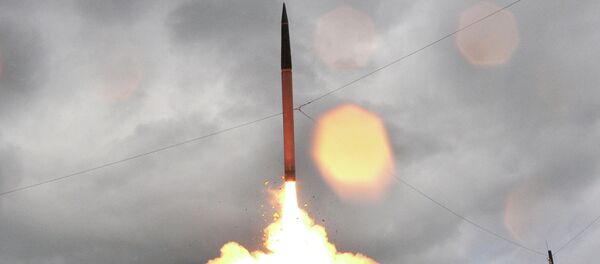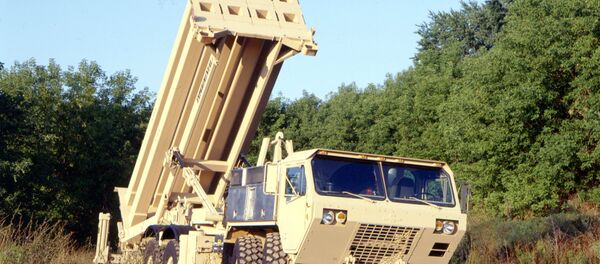James Mattis said that were it not for Pyongyang's "provocative behavior," there would have been no need for the Terminal High Altitude Area Defense (THAAD) system in South Korea.
THAAD has been touted as a way of thwarting North Korea's ballistic missile threats against South Korea and Japan, but China and Russia say they’re extremely concerned about their own security being compromised by the anti-missile system’s powerful radar.
Russian and Chinese security officials issued a joint statement where the two countries agreed to take unspecified “countermeasures” in response to the planned US deployment of an anti-missile system to South Korea.
The countermeasures will be “aimed at safeguarding interests of China and Russia and the strategic balance in the region.”
Russia's political analyst Dmitry Verkhoturov commented to Sputnik on the recent developments in the region.
"The deployment of the THAAD system, as well as other activities of the US and South Korea in region, such as large scale military drills, are really leading to the escalation of tensions and pushing North Korea if not towards war, than towards further accelerated development of its military potential," reads his article for Sputnik.
The political analyst further explained that from the point of view of its technical capabilities, THAAD only provides limited defense from missile strikes.
Secondly, the THAAD system has only 48 countermissiles in one battery. There are five batteries, hence, the total number of countermissiles is 240.
Meanwhile, North Korea has in possession the Hwasong-5 and Hwasong-6 missiles, also known as modernized Scud-B and C, which have ranges of 300km and 500km respectively. There are up to 600 Hwasong-6, not to mention other modifications. The total amount of missiles, including Hwasong and Nodong, with a range of about 1,000km, might reach 1,000.
It means that if a war does break out, North Korea will be able to overwhelm the THAAD system. In fact, in the face of several hundred missiles, South Korea will be almost defenseless, even if THAAD is fully functioning.
Thirdly, Pyongyang has a variety of other means to hit targets on the territory of its Southern neighbor, and in Seoul in particular, the expert says. These include tube artillery, such as long range self-propelled howitzer Koksan and multiple rocket launchers, with a range of up to 190 km.
Fourthly, Dmitry Verkhoturov notes, one should not underestimate the potential of North Korea in engaging in unconventional modes of warfare.
The political analyst cites as an example the reports of November 2016, which said that North Korea had launched a mysterious campaign to collect aluminum foil for the country's army. The idea was laughed at in the media, however there is nothing funny about it, the expert says.
The method, he says, has been used since World War II to defeat enemy radar. While the whole US anti-missile defense system, and THAAD in particular, is based on radar data, the massive use of aluminum foil cut into strips will create a radar "cloud" and deflect all the radars, making them useless.
Apart from this simple and cheap method suitable for use in almost unlimited qualities, North Korea might use so-called false missiles. After THAAD spends all of its countermissiles there will be another launch with the conventional warheads, including those with nuclear capabilities.
So it is clear that THAAD is unable to ward off a potential full-scale missile attack by North Korea. This suggests that the real purpose of the THAAD deployment is not about defending South Korea, but actually about defending US military facilities in the region, including on the territories of both South Korea and Japan, Verkhoturov says.
In case of a large-scale military conflict with the use of nuclear weapons, the expert says, the base sites of the nuclear weapons' carriers become the primary targets. Hence the American command is eager to defend its nuclear weapons' carriers from a potential strike to be able to deliver its nuclear missile attack at a close distance, and it is not important whether it is from North Korea, China or Russia.
Dmitry Verkhoturov further explained that since the term of President Harry Truman (1945-1953), the American nuclear war strategy has always foreseen the opportunity of an unchallenged first strike. This explains the US interest in anti-missile defense systems, and in this region in particular, he said.
While deploying such an "umbrella" for its nuclear forces in Korea and Japan, the US will then be able to blackmail Russia, China and other countries of the region which it does not consider "allies" with the threat of nuclear attacks.
Both Russia and China are aware of this, which explains their strong opposition to the THAAD deployment in South Korea. While the anti-North Korean rhetoric may go down well in the West, Russia and China aren't buying it, he explained.
THAAD Deployment in South Korea brings nuclear war in the region "tangibly nearer," he warned.
The views expressed in this article are solely those of the author and do not necessarily reflect the official position of Sputnik.








